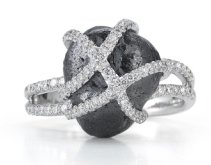The Ring?
March 21, 12
After more than six years of writing about diamonds and jewelry, I am finally looking at getting a diamond ring of my own. Yes, I just got engaged and among the whirlwind that this exciting new status brings with it, one of the key decisions is the ring or should I say the ring?
 Ring by Diamond in the Rough |
Almost from the second I announced my engagement, the ring finger on my left hand has become the center of attention. At the moment, it is decidedly naked and is likely to remain that way for some time to come. You see, I am having trouble in the engagement ring department.
Whenever the subject of a potential engagement came up, I told my boyfriend in no uncertain terms not to go shopping without me. What would I do, I thought if he went out and bought something I hated? How do you explain that? Do I go through my whole life wearing a ring I don’t like? Better, I thought, to do away with the romance and address the issue from a practical angle, like the right-hand ring woman I am.
Alas, for my poor fiancé, I am a girl who knows her own mind a little too much when it comes to diamonds. I don’t want a run of the mill solitaire – too boring, nor do I want a white diamond – too common. I am sorely tempted by a grey diamond, which is one of this year’s top engagement ring trends, according to the Jewelry Information Center. I am also completely in love with the whole idea of a rough diamond and have spent hours checking out Todd Reed’s designs as well as those on the newly re-launched website of Diamond in the Rough.
But more than the shape, the design, even the finish of the diamond, I have been mulling over the origin of my future diamond.
As someone who has been to Africa, I have seen first-hand the benefit that the diamond industry brings to people. In Johannesburg, I visited the African Children’s Feeding Scheme, which both Anglo American and De Beers support. Through the scheme, more than 31,000 children from poverty-stricken homes are fed each day. In Botswana, I visited the Tioweng Children's Village in Gaborone, which is again supported by De Beers as well as diamond manufacturer the Dalumi Group. At the Orapa diamond mine, I heard about the work done to support the communities around the mine and at the DTC Debswana, I learnt about the various health projects sponsored by the company.
While there is no doubt that buying an African diamond benefits countless numbers of people on that continent both directly and indirectly, I am also swayed by the idea of a Canadian diamond. I love the idea of the purity inherent in the Canadian diamond branding thesis, something I learnt more about while researching one of the articles for this month’s Focus, which examines the past and future of the Canadian diamond sector.
I don’t yet know where my diamond will come from, but I do know that no matter what I decide, I want to know where my diamond originated. I want to be able to know – if possible – where it was mined so that I can visualize the story and the people behind it. I want to know that by buying a diamond from a particular place, I am helping – albeit indirectly – a person or a particular community. Perhaps this narrative aspect is something that not everyone would be interested in; no doubt some people will be more concerned with the size of the sparkly gem on their finger, but I want to know. I certainly think that the story of diamonds is something that needs to be better emphasized.
What I also know is that whatever we choose, it will be forever.